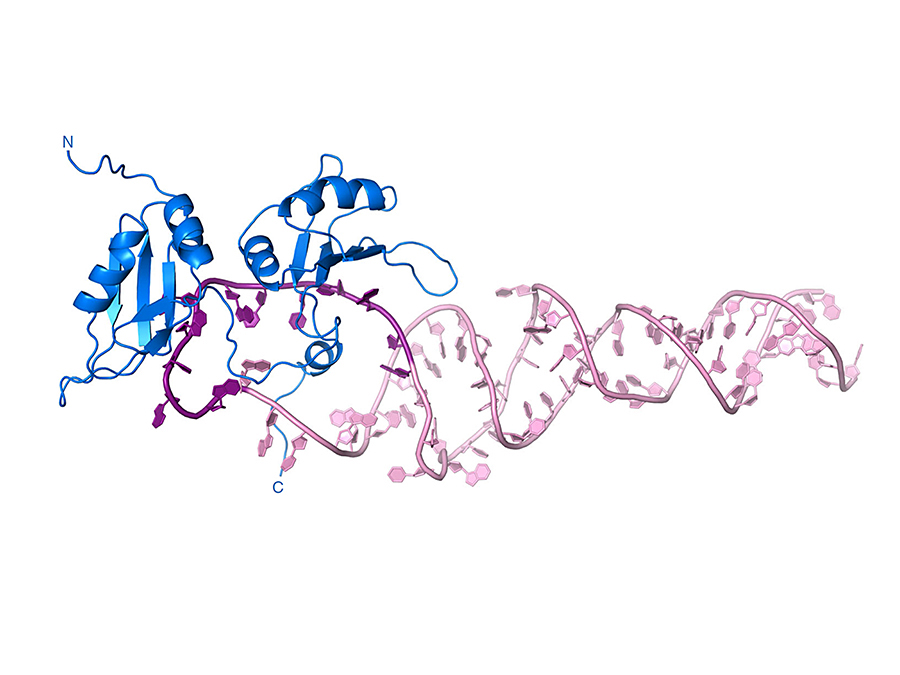Elucidating the maturation mechanism of a cancer-causing microRNA
New Insights into the Maturation of miRNAs

MicroRNAs (miRNAs) are a class of molecules consisting of short RNA sequences that inhibit the formation of certain proteins by destroying the corresponding RNA blueprint.
Cancer-causing miRNAs, so-called oncomiRs, also function according to this principle and inhibit the production of proteins that protect the cell against uncontrolled growth.
"Thus, an increased presence of these molecules in cells leads to the development of cancer in the long term," said Professor Michael Sattler, director of the Institute of Structural Biology at Helmholtz Zentrum München and professor of Biomolecular NMR Spectroscopy at the Technical University of Munich (TUM). "However, some molecular mechanisms of miRNA maturation in the cell remain elusive.”
Maturation of miRNAs
Usually, before a miRNA can act in the cell, it undergoes several maturation steps and develops from a so-called primary pri-miRNA via a precursor stage (pre-miRNA) to a mature miRNA.
In the current study, Professor Sattler together with researchers led by Professor Javier Caceres and Dr. Gracjan Michlewski from the University of Edinburgh and his former doctoral student Hamed Kooshapur (now at the National Institutes of Health, USA), investigated the maturation of a specific pri-miRNA.
"Our research focused on the maturation of miRNA-18a, which has been associated with colon, breast, and esophageal cancer,” said Michael Sattler. "To elucidate how its maturation is controlled, we had to combine different procedures. Nuclear magnetic resonance (NMR) spectroscopy, X-ray crystallography, small-angle X-ray scattering analyses as well as biochemical experiments were used."
Basis for therapy development
Using this combination approach, the authors were able to show exactly how a specific RNA binding protein (hnRNP A1) recognizes pri-miRNA-18a and changes its structure in such a way that it develops into mature miRNA-18a.
The researchers assume that the mechanism can also be transferred to other miRNAs. "In the long term, understanding these processes might help us to develop new therapy options – for example to treat cancer," said Sattler. "Only if we understand how biology works we can intervene in a targeted manner."
Publication:
Hamed Kooshapur, Nila Roy Choudhury, Bernd Simon, Max Mühlbauer, Alexander Jussupow, Noemi Fernandez, Alisha N. Jones, Andre Dallmann, Frank Gabel, Carlo Camilloni, Gracjan Michlewski, Javier F. Caceres and Michael Sattler
Structural basis for terminal loop recognition and stimulation of pri-miRNA-18a processing by hnRNP A1
Nature Communications, (218)9:2479 – DOI: 10.1038/s41467-018-04871-9
Further information:
This work was supported by the Deutsche Forschungsgemeinschaft (SFB 1035, GRK 1721 and Cluster of Exfellence Center for Integrated Protein Science Munich), the Medical Research Council (UK) and the Wellcome Trust as well as the TUM—Institute for Advanced Study, funded by the German Excellence Initiative and the European Union Seventh Framework Programme.
SAXS and SANS measurements at DESY (Hamburg, Germany) and at the Institut Laue-Langevin (Grenoble, France), NMR-measurements were done at the Bavarian NMR Center (Garching, Germany), X-ray crystallography at the Helmholtz Zentrum München and further SAXS measurements at the facility of the SFB 1035 at Department Chemie of the Technical University of Munich. Further cooperation partners were the European Molecular Biology Laboratory (Heidelberg, Germany), the University of Grenoble Alpes (France) and the Zhejiang University (China).
Contact:
Prof. Dr. Michael Sattler
Technical University of Munich
Chair of Biomolecular NMR Spectroscopy
Lichtenbergstr. 4, 85748 Garching, Germany
Tel.: +49 89 289 13418 – michael.sattler@ch.tum.de